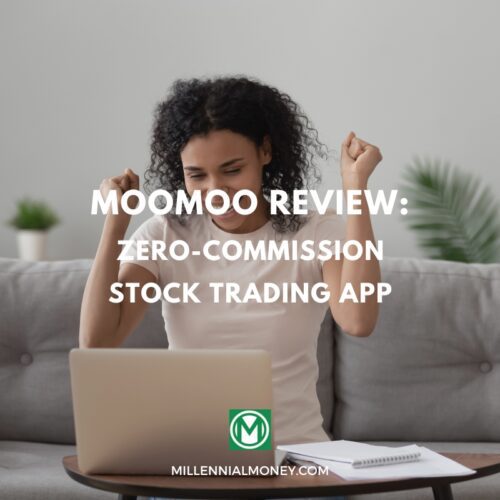Today it’s more common than ever to find investing platforms that charge no trading commissions. It started with a few brokers, and today it’s almost the norm, which is why it’s not surprising that J.P. Morgan Self Directed Investing has jumped on board.
The J.P. Morgan Self Directed Investing platform works through the Chase mobile app. However, it’s a simple investing platform without all the bells and whistles. So if you’re looking for a simple investing platform, you’ve found it.
Using the J.P. Morgan Investing Platform
The J.P. Morgan investing platform is great for people using Chase for most of their banking needs. It integrates well with the Chase app and only takes a few minutes to open a self-directed account.
It’s best for long-term investors or those who want to set it and forget it. Investors can choose between stocks, mutual funds, ETFs, and bonds and pay no commissions.
How It Works
While the J.P. Morgan investing platform doesn’t have a lot of bells and whistles, you can set up watch lists and have opportunities to research investment opportunities.
However, when you log into your account, you’ll see a complete overview of your portfolios. J.P. Morgan feels that less is more when it comes to investors understanding their portfolio information.
Investors can access their accounts online or through the Chase.com app, and if you have at least a $2,500 balance, you can use the Portfolio Builder Tool. This tool shows you how a new investment would affect your portfolio.
You’ll also find other helpful tools, including screeners, fundamental and technical analyses, and some educational resources.
Chase and J.P. Morgan Integration
The nice thing about the J.P. Morgan Self-Directed Investing platform is it integrates with Chase.
So if you’re already a Chase customer, you can have all your accounts in one app, making it easy to manage.
INVESTMENT AND INSURANCE PRODUCTS ARE: NOT A DEPOSIT • NOT FDIC INSURED • NO BANK GUARANTEE • MAY LOSE VALUETrade Experience With J.P. Morgan Self-Directed Investing
Because the J.P. Morgan Self-Directed platform doesn’t have a lot of complicated features, it’s easy to use. You can invest independently (self-directed) or with a robo-advisor (passive investing).
However, remember that the robo-advisor option charges 0.35% of assets under management fee, whereas the self-directed option has $0 commissions.
The Mobile Trade Experience
Using the Chase app, you can easily transfer money to and from your investment accounts, search for specific stocks, and monitor your portfolio’s performance. The mobile app is available on iOS and Android platforms and lets you see your investments and all bank accounts with Chase in one place.
You can access most of J.P. Morgan’s trading tools in the mobile app, including screeners, J.P. Morgan Equity Research, Quote, Watchlists, and ChartWorks.
Trade Technology
When executing electronic orders, J.P. Morgan uses several processes. Primarily they use smart order routing (SOR), which uses an algorithm to route trades based on various factors.
When you sign up for a J.P. Morgan trading account, you must sign an agreement that you’ll abide by all laws, rules, and regulations regarding electronic trades.
Types of J.P. Morgan Accounts
Knowing the type of J.P. Morgan accounts you can open will help you determine if it’s a good fit, and J.P. Morgan offers several options.
Of course, you can open a taxable investment account, but there’s the option to have a single or joint brokerage account. You can also open a traditional or Roth IRA if you’re saving for retirement.
Range of Self-Directed Investments Product Offerings
No matter the type of account you open, there is a wide range of self-directed investment products you may consider including the following:
Four Basic Order Types
Investors have four options when placing a trade order with J.P. Morgan Self-Directed Investing, including:
- Stop Limit
- Market
- Limit
- Stop Order
These orders are available on the website and mobile app.
However, J.P. Morgan doesn’t offer more sophisticated order types, such as conditional orders, which experienced investors often want.
Reliability and Security
J.P. Morgan and Chase Bank are well-known entities in the investment and banking industry. J.P. Morgan belongs to FINRA and the SIPC, and they use bank-level security to encrypt and protect your information.
To access your accounts, you must use two-factor authentication, and J.P. Morgan offers a certain degree of fraud protection if they are at fault.
Like any investment or bank account, you should use caution when sharing passwords or accessing accounts to keep your information private.
You should also consider your risk tolerance and the riskiness of any investments you choose, as there’s no guarantee of a positive return.
Who Self-Directed Investments Are Best For
J.P. Morgan Self-Directed investments are best for certain people.
Because the platform is simple, advanced investors might not find what they need; however, the following investors may benefit.
- Current Chase Customers – If you bank at Chase, you’ll love the simplicity of having your investment and bank accounts in one dashboard. You can access all information at once and make more informed decisions.
- Beginning Investors – If you’re new to investing, the J.P. Morgan platform may ease you into the complex world of investing. You don’t have to worry about overwhelming tickers, charts, and other complex tools getting in your way. Instead, you can clearly identify your portfolio’s progress, make changes, and get your feet wet in investing.
- Passive Investors – J.P. Morgan offers a robo-advisor option that automates your investments if you prefer a set-it-and-forget-it mentality. You choose a premade portfolio, and they manage and reallocate it for you. This works well for new investors or those seeking a long-term, passive investment strategy.
Cost
Like many investment platforms, there’s no cost to trade stocks, ETFs, mutual funds, and options. However, options have a $0.65 contract fee. Bonds and fixed-income assets have a $1 commission per asset.
Like most platforms, J.P. Morgan charges other fees, including returned checks, stop payments, wire transfers, and broker-assisted fees.
J.P. Morgan is highly transparent about their pricing and fees. Most fees are displayed on their website, although you may have to read footnotes and fine print to find them.
Account Features
Account features are an important part of any investment platform. Here’s what J.P. Morgan Self-Directed Investing offers:
- No account minimums – It’s a nice feature not to worry about reaching a certain threshold to invest. This is especially helpful for new investors.
- Bonuses – For a limited time, you may earn a bonus depending on how much you invest. The bonuses increase the more you invest.
- Web and mobile access – Investors can access their account online or through the Chase mobile app, allowing them to invest wherever it’s most convenient
- Retirement account options – Investors can open a taxable or tax-advantaged (retirement) account
Portfolio Analysis Tool
The Portfolio Builder Tool helps investors develop new investing ideas and see how they fit into their portfolios before investing.
Additional Tools and Calculators
Charting
J.P. Morgan Self Directed Investing has some charting capabilities and drawing tools on both its mobile and desktop versions.
Research Amenities
J.P. Morgan Self Directed Investing offers a handful of proprietary and third-party research opportunities. Here’s a quick overview:
- Available Third-Party Research: J.P. Morgan offers Morningstar ratings in its screeners. It also provides access to CFRA Research on more than 3,000 companies.
- J.P. Morgan Equity Research: The service also comes with unique access to J.P. Morgan Equity Research, which covers approximately 1,200 companies.
- SRI and ESG Research: If you want to focus on socially responsible investments, J.P. Morgan offers an option to filter for only SRIs in ETFs and mutual funds.
Screeners
Screeners help narrow your investing options, and J.P. Morgan offers several, including stock, ETF, and mutual fund screeners. They are available on the website and mobile app and have the most robust filters out of all the screeners. You can also save screens for use in the future.
Market News
Investors can subscribe to a biweekly newsletter for trade ideas, market news, and other trend information. You can also access news about any assets on your watchlists.
Tools for Cash Management
Investors can choose to have cash swept into a standard bank account or a money market fund sweep for higher interest.
DRIP (Fractional Dividend Reinvestment Plans)
Investors can choose to have dividends reinvested automatically, and you can purchase fractional shares with the dividends to maximize your earnings.
Educational Resources
Investors can subscribe to a twice-monthly newsletter called “The Know: In Focus” which includes articles and videos. They include information about trading, economic outlooks, retirement tips, and investing basics.
Access to Customer Service
Investors can contact customer service online, in the app, and in person. You can visit a local branch during regular banking hours, use the Chase Digital Assistant chat option in the app, read the FAQ on the website, or call a licensed advisor during normal business hours.
Pros and Cons
Pros
- The Mobile App – J.P. Morgan Self-Directed Investing integrates with the Chase mobile app. If you bank at Chase, this makes it easy to see all your accounts in one place. It also allows for seamless transfers between accounts and investing on the go.
- The platform is easy to use – The J.P. Morgan Self DIrected Investing Platform is easy to use because it doesn’t have a lot of features. For some, this is a downside, but if you like a clean and simple interface, this one’s for you.
- No Minimum Investment Requirements on Accounts – New investors can start with as little money as they want, as there isn’t a minimum investment requirement.
- Stock, Options, and ETFs Commissions – Investors can trade stocks, options, and ETFs for no commission.
- No Commission on Mutual Funds – Investors can also trade mutual funds for no commissions, which is rare.
Cons
- No Fractional Shares – Investors only have the option for fractional shares with reinvested dividends, not regular investments.
- Limited Types of Accounts – Investors can choose a taxable or retirement account, but only a Roth or traditional IRA. They don’t offer SIMPLE, SEP, or individual 401Ks.
- Must have a $2,500 Balance to Use the Portfolio Builder – To take advantage of the Portfolio Builder tool, you must have a $2,500 balance.
Alternatives
J.P. Morgan Self Directed Investing gets right to the point. You won’t find a lot of frills like you would in other options.
But, if you’re looking for a simple interface with no commissions that allows you to invest your funds easily, J.P. Morgan Self Directed offers it.
In addition, you can choose a robo-advisor or a self-directed trading option like M1 if you don’t want the pressure of handling the investments yourself.
Frequently Asked Questions
J.P. Morgan Self Directed is a great low-cost platform. Here are some common questions people have about it.
Is J.P. Morgan a Legitimate and Good Company to Work With?
J.P. Morgan Chase is the largest bank in the country, so the backing J.P. Morgan Self Directed Investing has is immeasurable. In addition, they have good ratings and provide many ways for investors to contact them with problems or concerns.
Is J.P. Morgan Self-Directed Investing Worth Using?
J.P. Morgan Self Directed Investing is worth it if you want a simple platform that doesn’t charge commissions. You’ll sacrifice robust research and tools but don’t have the hassle of learning a complicated platform to handle your investments.
How Do You Open an Account With J.P. Morgan?
If you’re a Chase customer, open your Chase app and click “Open an account”. If you aren’t a Chase customer, you must download the app first; then, you can sign up for an account. After signing up, you must verify your identity and employment to open an account.
Who Isn’t J.P. Morgan Self-Directed Investing Good For?
Advanced investors who are used to complex tools or want robust research options would be better off looking elsewhere for their investment platform.
Should You Use J.P. Morgan Self-Directed Investing?
J.P. Morgan Self Directed Investing has its pros and cons. It’s great for beginners or anyone not ready for a complicated platform but could lack the speed and resources advanced investors need.
But, if you’re already a Chase customer, it can help you build a larger portfolio with no commissions and allow you to have all your funds in one place.





No comments yet. Add your own